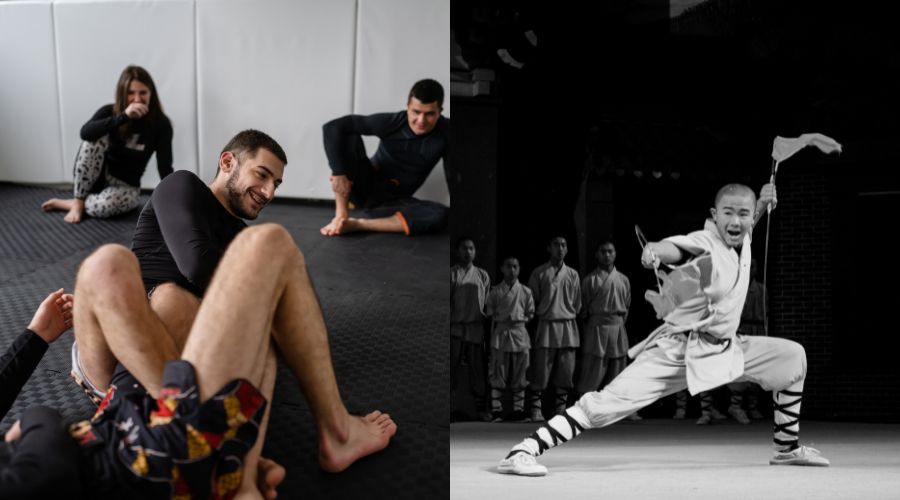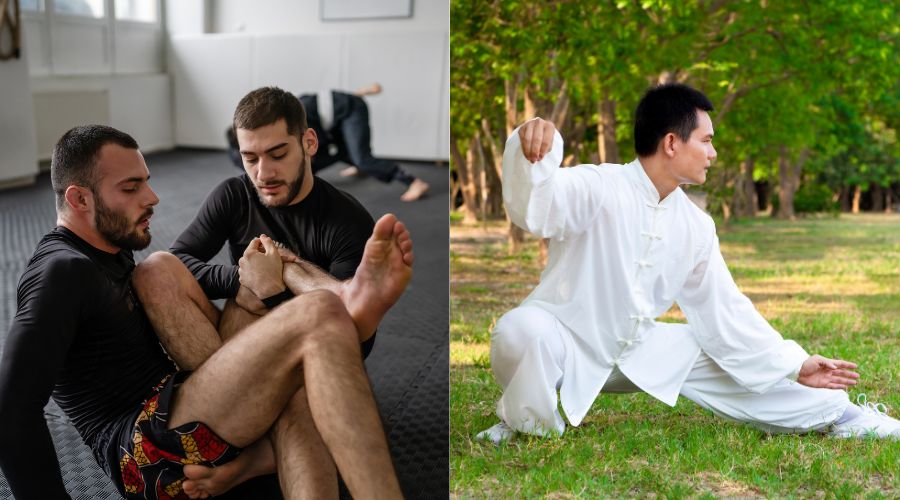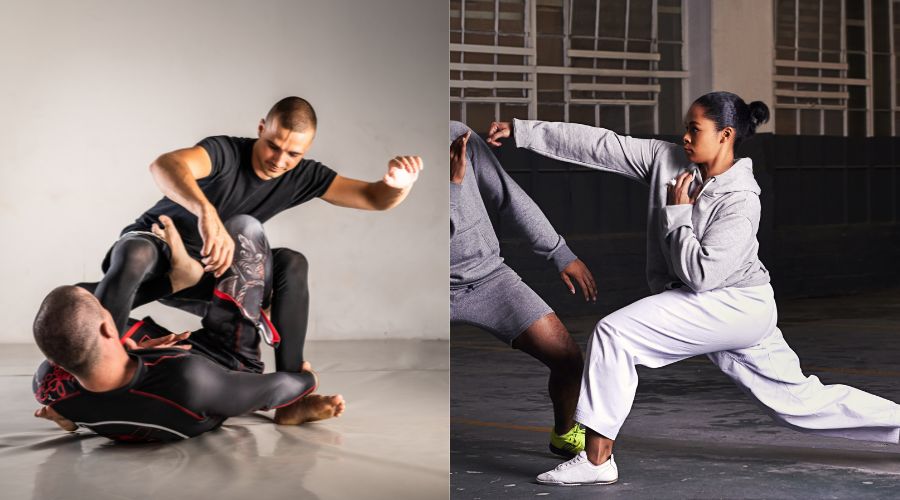While Kung Fu sparked the martial arts craze in the Western world in the 1960s and 70s, today, many other styles have greatly surpassed it in number of practitioners and popularity, including BJJ. Nonetheless, many people are still interested in kung fu and wonder how it compares to jiu-jitsu.
BJJ is a grappling martial art and a developed combat sport. Kung fu is an umbrella term for Chinese martial arts that can be radically different from each other. Still, most have no competition element and are inferior to jiu-jitsu in effectiveness.
This being a BJJ site, most of you should be thoroughly familiar with the style, so the bulk of this article will deal with Kung Fu and, most importantly, how it fares against Jiu-Jitsu in its effectiveness for MMA, self-defense, and a direct battle between the two.
What Is BJJ
Brazilian jiu-jitsu is a grappling martial art emphasizing leverage and technique to secure dominance on the ground, ending with a submission or complete control.
The style was created as an extension of judo and catch wrestling taught by Mitsuyo Maeda to the Gracie family in Brazil in the 1920s. While they are not solely responsible for the evolution of the style, the Gracies have been the main force behind creating and popularizing it, first in Brazil and then in the USA and worldwide.
After MMA hit the mainstream within the first few years after the UFC was created, BJJ gained massive popularity worldwide. What was mainly a self-defense system for one-on-one fighting became a hugely popular grappling sport and a fundamental part of mixed martial arts.
What Is Kung Fu
While many traditional martial arts have sub-styles and the main name is more of an umbrella term, none are as broad as kung fu. Kung Fu is a system of Chinese martial arts that includes many sub-styles, each with a different approach, set of techniques, and philosophy.
The story of Kung Fu can be traced back thousands of years, but the concepts of distinct styles and not martial skills taught by lineage appeared during the Ming dynasty (1368–1644).
The richness of martial arts styles corresponds to the vast territory of China, the population, and the geographical variance. Many classifications exist to differentiate the styles, like geographical, external or internal, religious influence, and others.
Out of this variety, a few main styles present a genuine interest in this article, and these styles have a large following not only in China but worldwide. These are:
- Shaolin Kung Fu
- Wing Chun
- Wushu
- Shuai Jiao
- Tai Chi
- Baguazhang
Internal styles like Tai Chi are notoriously bad as fighting styles. They are excellent spiritual practices and have physical benefits. Still, their effectiveness in even light contact fighting is nonexistent, so there is no point in comparing them to BJJ, which is a fighting system.
The only competitive style of Kung Fu is Wushu, which is again an umbrella term for many substyles. Most of the disciplines are choreographed, and participants are judged on the cleanliness of their technique, much like in gymnastics.
The only style that is a combat sport in the modern understanding of the word is Sanda, also called Chinese kickboxing.
Key Differences Between BJJ and Kung Fu

Rules
Sanda is the only comparable sport to BJJ from the myriad of kung fu styles. Here are the key features and rules of both sports:
Rules and key features of BJJ
- Grappling only, no striking allowed
- Matches are played on open mats
- A match can be won by a submission or on points
- Points are awarded for securing a takedown, a sweep, or dominant positions like mount, side control, or back control
- There are two main variations- gi and no-gi
Rules and key features of Sanda
- Sanda is predominantly striking, but it has a strong standing wrestling element.
- All kinds of punches and kicks to the head, torso, and legs are allowed
- Throws, sweeps, and trips are allowed and scored. The attacker must remain on his feet to receive points for the takedown.
- Clinching for up to 5 seconds to attempt a takedown is allowed
- Bouts take place on an elevated platform called a “leitai,”
- Most Sanda competitions use protective gear in the form of head guards, chest guards, and shin guards, but the level of protection may vary
Training

Training methodology is the most crucial element in determining whether a martial art will be effective outside of a preplanned sequence or not. BJJ is as good as it is because most training revolves around free sparring, called rolling, and drills against at least a mildly resisting opponent.
Most kung fu styles do not have any live resistance training or sparring and practice mainly forms and techniques in the air, with some partner drills but without any actual resistance.
Sanda is the style breaking this mold because it is a competitive, full-contact style. Training in Sanda is similar to what you would do in a typical kickboxing or Muay Thai gym.
Outside of physical training, though, kung fu is its strongest. All styles are inclined heavily towards philosophy, spirituality, self-awareness, and a holistic approach to life, not just combat. It also has a strong traditional cultural element.
Equipment
Brazilian jiu-jitsu does not require a lot of equipment for training because it has no striking, hence no need for protective gear. But it still has a set of stuff you need, which includes:
- A BJJ gi
- BJJ Rashguard
- BJJ Fight shorts
- Mouthguard
- Groin guard
Kung Fu equipment largely depends on the style you are training in. For Sanda, which is the only truly comparable style you will need:
- Boxing gloves
- Shinguards
- Head Guard
- Mouthguard
- Groin guard
BJJ vs Kung Fu For MMA
By now, the effectiveness and claims of actual fighting effectiveness of most kung fu styles have been thoroughly debunked. But this does not refer to Sanda. As a full-contact competitive style, Sanda is an excellent base for mixed martial arts because it covers the striking aspect competently and has some incredible takedowns and trips.
Like any other style, it needs some modification before being fully applicable in a cage fight. But after this, Sanda can be an excellent base for MMA, with Cung Le being the most famous fighter to transition from Chinese kickboxing to the MMA big leagues.
There are more examples, like Weili Zhang, Muslim Salikov, and many others.
BJJ’s effectiveness in MMA needs little explanation. The style is one of the foundations of mixed martial arts and must be practiced by every MMA fighter, regardless of their level. You may not be good at applying submissions or ever attempt one, but submission defense and ground position skills are mandatory.
BJJ vs. Kung Fu For Self-Defense

It’s easy to figure out that BJJ is infinitely better than Kung Fu for self-defense because training involves sparring and constant pressure testing.
While BJJ has flaws in real fights, mainly in the absence of any striking, it still allows experienced practitioners to dominate most of the population in an unarmed fight.
Kung Fu, on the other hand, with its forms and choreographed training, has no actual testing field. So, practitioners never learn what fighting with a resisting person feels like.
Again, Sanda must be excluded from this statement because it’s an excellent self-defense system covering striking distance management and standing grappling, arguably the most important aspects of a real-life altercation.
BJJ vs. Kung Fu: Who Would Win?
Thankfully for us and everyone interested in the truth, there are quite a few instances of people from different styles fighting against kung-fu practitioners, and the result is always the same- the obliteration of the kung-fu guy.
As I’ve mentioned in the previous paragraphs, kung fu styles without sparring are useless in any fight, whether with rules or without. Here is video footage of two guys both training around 10 years of BJJ and kung fu, respectively:
Perhaps the biggest detractor to kung fu as an actual fighting style is a Chinese man called Xu Xiaodong. Angry at the insane amounts of fake martial arts and claims around him, he embarked on a quest to demonstrate the truth.
As expected, he beat badly a few kung fu masters, but the feat was not received favorably as it was seen as a direct attack on Chinese culture.
Tai Chi is especially bad for fighting, and the results of fights between Tai Chi masters and actual fighters, even hobbyists, are not funny but rather sad.
With that said, Sanda is a legitimate fighting style with a lot of success in cross-style battles, and its comparison with BJJ is worthy, especially given that Sanda has many throws in it. This is also why Sanda is an excellent base for MMA.
But like any other striking style, BJJ will easily win if the fight goes to the ground. And while Sanda guys have a decent takedown defense, the fight will eventually hit the ground in most cases.
One of the few instances of such a fight I have found is actually of the same Xu Xiaodong who went on to beat the fake masters later in his life.
Which Is Better?
No martial art can be better than the others in all aspects. That said, Brazilian jiu-jitsu is far superior to most kung fu. It’s realistic, effective in MMA and self-defense, and has a super-developed sports scene so that you can compete at any level and age.
Kung fu can be better for those looking into a philosophical and spiritual system loosely based on martial arts. It’s much gentler on the body and does not require the same level of exertion.
And yet again, Sanda deserves a separate mention as an entirely legitimate fighting style, which is better for you if you want to learn striking. The problem is that there won’t be any available Sanda schools nearby (or within a few hundred miles) for most people worldwide, while BJJ academies are everywhere and still growing in numbers.
